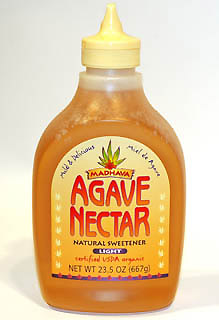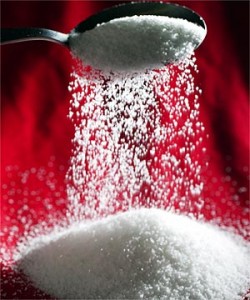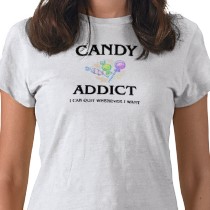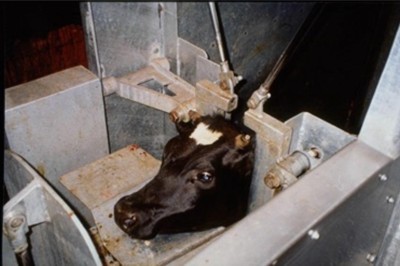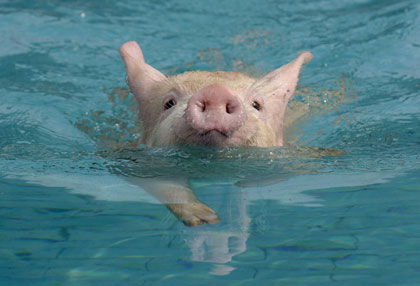Archive for the ‘Scary Motivation!’ Category
-
Day 50: He Tells You How to Quit Sugar!

London’s Independent has this article about how to quit sugar inspired by the work of addiction expert Patrick Holford.Reprinted from the Sunday Independent
Get rid of that sweet tooth: How to quit sugar
By Sophie Morris
So much for Mary Poppins. All those spoonfuls of sugar are not only making us fat, they’re contributing to arguably the biggest health threats facing humanity: diabetes, caused by soaring levels of obesity. Eating too much sugar can also make us tired, irritable, anxious, spotty and aggressive, and lead to insomnia.Why do we eat so much sugar?
You shouldn’t feel guilty about enjoying sugary foods. Human beings are designed to like sweet things – a clever physiological trick to save us from the poisonous plants and berries, which usually have a bitter taste.
Before the agricultural revolution, however, the only sugar we could get in our diet occurred naturally. Starchy foods such as rice, wheat, corn and potatoes – and then bread, noodles and pasta – soon became our principal source of energy. In itself, this didn’t cause too many problems, until someone hit on the idea of processing raw sugar into the refined white stuff you find in most kitchen cupboards – and adding liberal helpings of it to almost every packaged and processed food on our supermarket shelves.
Most people’s sugar hits start right at the beginning of the day with a bowl of breakfast cereal, laden with delicious, sweet additives. Even if you think you’re being clever and eating porridge mixed with dried fruits such as raisins, you are still ingesting a fair whack of sugar. In fact, the sugar in raisins raises your blood sugar in the same way as white refined sugar. Apples and pears contain fructose, which raise your blood sugar about 50 per cent slower than grapes; berries, plums and cherries contain xylose, which releases blood sugar 50 per cent slower again.
Other culprits, aside from the obvious sugary drinks, are processed sauces and soups, which have often been sweetened.
Why is sugar so dangerous?
The UK is rushing headlong into a diabetes crisis fuelled by increasing obesity. Both conditions are linked to the intake of too much sugar and refined carbohydrates. When you pump your body full of sweet things, blood-sugar levels rocket and the body releases insulin in order to remove this excess of sugar from the bloodstream. Where does it put this extracted sugar? On your hips, tummy and bum, in the shape of fat.
Patrick Holford is the author of a new book called How to Quit without feeling S**t which treats the issue of sugar addiction as seriously as heroin, alcohol and nicotine. “The root of most of today’s killer diseases is actually blood sugar problems,” he says. “So the goal becomes, how do you keep your blood sugar even?”
Sugar cravings
Keeping one’s blood sugar even is a bit of a vicious circle. We need to feed our bodies to stave off energy slumps, but doing that with hits of sugar will not help in the long term. Have you ever experienced that mid-afternoon slump after a carb-heavy lunch? No doubt you think it means you need more energy to get through the afternoon, and will fend off the fatigue with a biscuit or, if you’re the healthy sort, apples or a banana.
The reason you slumped in the first place is because you ate too many carbohydrates for lunch, instead of a balanced meal with plenty of protein. Plugging that gap later on with yet more sugar will make you feel worse, and most likely less able to concentrate. Studies even show that plenty of non-obese people have developed insulin resistance, no doubt because their bodies have become accustomed to being fed sugar with such regularity, and have stopped bothering to break it down.
There are also strong correlations between the level of sugar in your blood and your mood. When people have low blood sugar they start feeling tired and perhaps depressed. They might become irritable, anxious, aggressive and find it difficult to concentrate. As a result, sweet foods are craved in order to bring that blood sugar back up as quickly as possible. “People who feel blue and then eat something sweet find it makes them feel better,” says Holford. “They are probably low in serotonin and they’ve learned that sugar makes them feel better.”
Regulating sugar intake
There are two main ways to balance blood sugar. The first is to avoid carbohydrates and follow a regime similar to the Atkins Diet, eating a high-protein diet. This method works for lots of people, who use Atkins as a loose blueprint for their approach to eating, rather than as a strict diet. The point is that carbohydrate, not fat, is the enemy. The demonisation of fat within the health and diet industry has led to even more sugars being added to apparently healthy, low-fat foods, in order to make them palatable.
The second way is to eat a diet that has a low “glycaemic load” (GL). The “glycaemic index” tells us how quickly the sugar from certain foods is released into the blood stream. What it doesn’t tell you is how much of that food is sugar. Holford says that it is better to control the amount of sugar we eat. “Atkins limited the amount of carbs, but didn’t pay so much attention to the GI,” says Holford. “The GI diet limits the fast-releasing GI sugars but doesn’t pay enough attention to the quantity eaten.”
For example: any food with a GI food of more than 70 is considered bad. Watermelon scores 72, but in a 120g slice there are only six grams of sugar. The sugar is released very quickly into the blood stream but there is not much of it.
Oat-based cereals are better than rice- or corn-based cereals. Beans, lentils and pulses are high in carbohydrate but low-GL; brown rice and wholewheat pasta are better than white, but quinoa is much better than any of these.
The good carb/bad carb debate seems to be ongoing, and no wonder: who wants to give up that bowl of pasta? The obvious solution if you really want to pull your body back from the brink of sugar dependency would be to limit foods that are high in sugar aggressively.
How to quit
The tricky bit. The act of coming off sugar has been likened to going cold turkey on a heroin habit. This seems fairly extreme, but, as we have seen, even those of you who don’t add three spoonfuls of sugar to your tea every morning are probably overloading on sugar with cereals and fruits.
“Depending on someone’s sugar addiction,” says Holford, “it takes between two and five days to come out of withdrawal from sugar. We’ve done work in schools where children are sugar-addicted. They feel flat and rough and lacking in energy for a couple of days after removing sugar. But within a week most people begin to experience more energy and more mental clarity.”
Beat the sweets: Tips for quitting
1. Make a low-sugar meal plan. Swap breakfast cereal for oats and try adding low-GL cherries or berries as a sweetener.
2. Eat little and often. This means three meals and two snacks, so have something on hand mid-morning – a handful of almonds should do the trick.
3. Up your intake of Vitamin C. One study showed that a very high intake of Vitamin C reduces blood sugar levels and lowers the damaging effects of sugar.
4. Use sugar replacements. Work out the times of day you eat something sweet and replace it with something less sugary. For example: a punnet of strawberries has the same effect on your blood-sugar levels as 10 raisins, or one date. Xylose, the sugar in berries, is available in supermarkets as xylitol. You can add this to hot drinks or porridge and bake with it. Manuka honey is a great replacement for refined sugars.
5. Stay off the caffeine. Sorry: you might have decided coffee was to be your crutch while you kicked sweets, but caffeine also disrupts blood-sugar balance. Antioxidants in green tea will help repair any damage done by yo-yoing blood sugar levels.
6. Get some help. Once you’ve balanced your blood sugar, you need to make sure insulin is working as it should. Cinnamon supplements will help with this. Tryptophan can help reduce sugar cravings (take 200mg a day) and tyrosine will help you deal with the low moods and flatness in the initial stages (take 500mg twice a day, but none too late in the day to avoid disrupting sleep).
-
Day 50: “How to Quit Without Feeling S**T”
The guy in the below video is Patrick Holford, who wrote a book called How to Quit Without Feeling S**T. (His stars, not mine.)
He calls his books “the fast, highly effective way to end addiction to caffeine, sugar, cigarettes, alcohol, illicit or prescription drugs.” He says your body betrays you when you start to give up an addictive substance – and he tells you how to fix your body with vitamins and nutrients so the withdrawals aren’t so bad.
Check out the video and will also be posting a Holford-inspired article about how to quit sugar later today.
-
Day 48: Just Say NO to Agave!
THIS SWEETENER IS FAR WORSE THAN HIGH FRUCTOSE CORN SYRUP!
By Dr. Joseph Mercola
Reprinted from the Huffington Post
Many people interested in staying healthy have switched to agave as a safer “natural” sweetener. They want to avoid well documented dangerous sweeteners like HFCS (high fructose corn syrup) but are unaware that most agave is actually WORSE than HFCS.
This expose will offend many hard core natural health advocates because they have been convinced of the agave hype by companies that are promoting it.
Some have even criticized me for having “ulterior” motives. But nothing could be further from the truth. Although I do offer natural health products for sale on this site, I sell no competing products to agave.
Rather, I recommend other options such as stevia products. You can also use xylitol in small amounts or glucose which is sold as dextrose and can easily be purchased on Amazon for $1 per pound. I do not sell any of these products.
My only purpose for sharing this information is to help people understand the truth about health. In case you haven’t noticed, we have an epidemic of obesity in the US and it wasn’t until recently that my eyes opened up to the primary cause – - fructose.
Keep reading the article here at the Huffington Post.
-
Day 48: Break Free of Sugar in 6 Weeks!
Want to get off candy and sweets like me but don’t have the motivation to start?
Connie Bennett, author of Sugar Shock and the Oprah of the quit-sugar world, is offering a new six-week teleseminar/webinar called “Break Free of Your Sugar Addiction in Six Weeks.” Click here for all the details. The course begins April 20.
Spring-clean your body and start fresh for summer 2010!
Connie knows what she’s talking about. She celebrated 12 years off sugar yesterday.
Below is from Connie’s description of the course:
- Are you fed up with feeling imprisoned by your out-of-control habit of eating candies, cookies, crackers and other quickie carbs?
- Do you feel discouraged, overwhelmed and frustrated because — no matter how many different diets or programs you’ve tried — you still haven’t overcome your sugar addiction and you keep packing on pounds instead of peel them off?
- And are you scared that bad health — such as type 2 diabetes, cancer, heart disease or Alzheimer’s Disease are out to get you and send you to your grave early because you eat so poorly?
- Are you agonized and at wit’s end because every single time you commit to quitting your sugar and carb habit — always with the best of intentions — you inevitably fail and end up packing away piles of potato chips, pasta and pretty desserts?
- Do you behave like this other sad, tragic, tormented person when you’re “high” on sugar or thinking of getting your next sugar “fix”?
- And does being trapped in a sugar habit hold you back from living your best life?
If you answer yes to any of the above questions, I can help you break free of your sugar addiction in a life-changing, 6-week teleseminar/webinar series that you’ll easily access by phone or the Internet.
If you’re frustrated, fed up and impatient with your sugar addiction and are ready now to lose weight, get more energy, be happier and feel free, then let me help you as I celebrate 12 years sugar-free this month.
-
Day 43: In Memory of Erin/Don’t Get in the Car
My blog about quitting candy is about fear in a way. Fear that I have just this one life and I’m capable of not taking full advantage of it.
(OMG. Yes, it’s…Earnest and Serious Sunday!)
Fear that if I don’t rein myself in on at least one self-destructive habit – eating candy – more will take over. Fear that every day I can sabotage myself in big and little ways.
Self-sabotage is a scary subject. My friend Barbara and I talk about the idea of “not getting in the car.” The idea comes from the 12-step fellowship rooms. Meaning “don’t get in the car” driven by someone drunk or impaired because you might be the one who ends up getting hurt – or worse.
It’s also meant in a larger sense. Like, don’t get involved with, or say yes to, something that’s not going to be good for you.
But sometimes if you grow up getting in the car when you don’t know any better, the car keeps calling to you even when you should know better.
Which brings me to my friend Erin, who not long ago had it all – looks, personality, money, adoring husband, gorgeous house, two beautiful Dalmatians – who died in January 2010.
When she burned to death in a fire, Erin, 44, was a divorced amputee living at home with her mother.
How could someone fall so far so fast?
This sounds mean and is not meant to be. But I think Erin brought her end on herself, probably unconsciously, and that’s scary.
It was as if she felt she didn’t deserve the great life she had and decided to wreck it. Literally. The below graphic is from the local CBS news station about her death.
I’m not using Erin’s last name because I don’t know all the facts leading to her death. We lost touch a few years ago and only reconnected on Facebook a few months before her death.
What follows is only my interpretation of events. Erin’s not here to explain herself. But her death shocked me and she haunts me. I miss her not being on the planet. She was one of the different, magic people.
When I met Erin shortly after 9-11 on an island off Brazil where my friend Mike runs a yoga, hiking and kayaking adventure week called Body Soul Adventures, she was a star. We bonded by trying to beat everyone in the mountain and kayaking races.
She was very pretty – a dead ringer for Sandra Bullock from some angles. She was charismatic. She had a high, sweet, excitable voice. She was fun and mischievous, somebody who made you feel life was an adventure.
She could be very loving and generous, routinely sending her friends around the country incredible care packages with candies they loved and cute clothing picked out just for them. She could sometimes be difficult. She’d push you to the point where you’d want to yell at her. One time I did.
Erin had amazing style. She was one of those people who always looked as if she had just walked out of a fashion magazine.
In conversations in Brazil, she described growing up on the wrong side of the tracks in California. Her father left when Erin was young and Erin hardly ever saw him.
Once, she said, when she was about 11, he showed up high on mushrooms and took her out driving in his car. Then he disappeared again.
Her mother was immature and sometimes neglectful, she said. Her mother used to keep her out of school whenever she felt like it and then take Erin for a lunch at Taco Bell.
But Erin was a survivor. “There was always a teacher who’d take me under her wing,” she said.
She grew up and went to a local college where she met her future husband, the scion of a wealthy, Social Register family, the kind you see in magazine and newspaper pictures of people at charity balls.
Erin and Peter (not his real name) got married and had an amazing life. Peter’s family seemed to be everything that Erin’s wasn’t. Erin said she loved Peter’s father, a wealthy businessman, as if he were her own.
Erin and Peter lived in an old, enormous house that Erin decorated and often filled with white roses. She and Peter had this huge bedroom with a fireplace, the ultimate cool boudoir. The Dalmatians slept there, too. “I’m obsessed with them,” Erin would say.
They threw popular parties. Her Halloween throw-downs were legendary. Erin loved candy like me. Big glass jars packed to the brim with candy corn and orange candy pumpkins dotted the rooms during her Halloween parties.
Below is Erin (on the right) with me and Mike Mitchell, who runs Body Soul Adventures in Brazil.
Erin got up every morning and went on a run with her dogs. She opened a yoga studio. She was a striver, all about self-improvement – at least for a time. When I visited her, I saw a word document on her computer listing her goals for the year.
But when I met her in Brazil, she had party girl tendencies that seemed to be intensifying. She kept a photo of her husband by her bed in her bungalow and it was clear she loved him very much – but made a fool of herself chasing a guy who was on the week with us.
After our abstemious week – exercising about 10 hours a day and eating only pure, organic food – about six of us hit Rio for a few days. We ended up in the bars on Copacabana Beach and began drinking lethal Caipirinha cocktails.
Erin got so drunk once that I had to help her out of the bathroom, where I’d found her with her with her jeans around her ankles.
When I visited her in California, I met her husband. Peter was rich and good-looking but not a player. He was a down-to-earth homebody who liked being at home with Erin and the dogs – and wanted kids.
Unfortunately, Erin was bored staying at home and didn’t want kids. She started having casual affairs, doing a lot of Ecstasy and flirting in front of Peter. “That guy’s in a lot of pain,” said our friend Gary at the time.
During one Thanksgiving I spent with Erin, everything seemed so wonderful. Peter’s family was nice and fun; Erin’s mother and sister were there also and everyone got along. The dining room table was decorated to perfection.
But before the meal was served, I saw Erin walking around the table, tearing up pieces of bread and dropping them on the plates – as if to mess everything up. It was strange and sort of disturbing.
By the time I moved to France in 2005, Erin and I had lost touch. The last time I saw her was at a party at my place in New York after which she went home with a guy she met at the party –and slept with him.
Erin and I reconnected on Facebook in 2009 but she never responded to my messages. I emailed her ex sister-in-law, Jill, who told me that she and Peter had gotten divorced. Jill then told me about the car accident.
Erin had hooked up with a “bad, bad boyfriend” after her divorce, she said, and had been a passenger in his car when they crashed.
Jill, for whatever reason, didn’t mention that Erin lost her leg in the car accident.
I didn’t find that out until I read the brief news accounts of her death. So even though I knew Erin wasn’t doing well, I was alarmed when I saw a post she wrote on her Facebook page last August in response to a message from another friend.
I’ve cut and pasted the post below:
Can’t – too down and depressed – just can’t deal with life anymore. I never have reason to smile anymore – in a few short words – everything I used to pride myself upon, is now sadly gone. I have grown to become lonely, painful and utterly bitter. I can’t feel happiness about anything and pathetically am beginning to feel uncomfortable around others who are/have what I once was. I don’t feel/ gain any hope from others – but rather bitterly find myself resenting others’ happiness, success with their lives and families. PLEASE UNDERSTAND…
August 29, 2009 at 4:06am
I was worried because she sounded suicidal. I emailed her but got no response. I emailed Jill who said that Erin had injuries from the car accident and was very depressed about them but also wouldn’t accept anyone’s help.
In January, I happened to click on Erin’s Facebook page. Her status update concerned the date and time of her memorial service.
I searched online for news accounts of her death – and was shocked to read her described as a “disabled woman” and an “amputee.”
The newspaper and TV reports varied as to what happened.
One said she died of smoke inhalation while trapped in her bathroom trying to extinguish some burning objects in the toilet.
Another account said that she died from burns covering 70 percent of her body. Someone who knows her told me she had left her bedroom fireplace unattended and then fell asleep.
The articles said her mother was leaning out of an upstairs window when firefighters arrived, yelling that her daughter was also inside.
Erin’s mother and cat were rescued and survived.
Later I learned that not long before she died, Erin had to put one of her beloved Dalmatians, Winnie, down and her alimony payments from Peter were about to end.
PLEASE UNDERSTAND…
-
Day 42: Are YOU a Sugar Addict? Find Out Here!
iVillage has a great little quiz you can take in case you’re wondering if you’re a hopeless sweetfreak like myself.
Here’s an excerpt from the quiz which starts like this:
Are you a sugar addict? Have you ever wondered why you love sweet foods so much? Does chocolate run your life more than you want to admit? Do you joke about being a “sweet freak?” Does it ever scare you to feel so compulsive about wanting sugar?
Find out if sugar is your drug — and whether or not it’s time to kick the habit — by completing the following quiz:
- Have you ever said, “Starting Monday, no chocolate!”
True
False
- Have you ever realized that you used to get one Butterfinger candy bar, but now you buy three at a time?
True
False
The quiz has 16 questions altogether:Take the whole test here!
And if you’re wondering how I did on the quiz…I passed with flying colors!Ta,
- Have you ever said, “Starting Monday, no chocolate!”
-
Day 40: OMG! Look What Has Sugar In It!
Shocking: Sugar Content of Common Food Products
By Daryo Pino, Huffington Post
Refined sugars and high-fructose corn syrup are considered by many experts to be the biggest contributors to obesity and poor health in Western civilization.
In her book What To Eat, Marion Nestle, professor of nutrition at NYU and blogger at Food Politics suggests that any food that contains more than 15 grams of sugar per serving is closer to dessert than anything else. Though this number is arbitrary, it is a good benchmark for evaluating food products.
Obviously sugar content is not the only factor in a food’s nutritional value (and not all of these have added sugar), but it can be illuminating to see the relative amounts in the foods we consume.
Just for fun I looked up the sugar content of a few common foods and menu items. I hope you’re as horrified as I am.
Listed values are as close to a normal serving as I could approximate. Units are listed as grams of sugar.
Sugar Content of Common Food Products
1. Krispy Kreme original glazed doughnut …………………………………………………10 g
2. Luna Bar berry almond …………………………………………………………………………11 g
3. Froot Loops breakfast cereal 3/4 cup ……………………………………………………12 g
4. Ben & Jerry’s vanilla ice cream ……………………………………………………………16 g
5. Starbucks caffè latte grande 16 oz …………………………………………………………17 g
6. Godiva 2 truffles ………………………………………………………………………………….17 g
7. Subway 6″ sweet onion teriyaki chicken sandwich ………………………………..17 g
8. Ms. Field’s chocolate chip cookie ………………………………………………………….19 g
9. Tropicana 100% orange juice 8 oz …………………………………………………………25 g
10. Yoplait original yogurt ………………………………………………………………………27 g
11. Craisins dried cranberries 1/3 cup ……………………………………………………….29 g
12. Vitamin Water 20 oz bottle ………………………………………………………………….33 g
13. Oscar Mayer Lunchables crackers, turkey & American cheese ……………….36 g
14. Coca-Cola Classic 12 oz can …………………………………………………………………..39 g
15. Sprinkles Cupcake red velvet ………………………………………………………………..45 g
16. California Pizza Kitchen Thai chicken salad ……………………………………………45 g
17. Jamba Juice blackberry bliss 16 oz ……………………………………………………….49 g
18. Odwalla SuperFood 450 ml bottle …………………………………………………………50 g
19. Starbucks caffe vanilla frappuccino grande 16 oz …………………………………..58 g
Take home messages:
* Foods we recognize as dessert (e.g. doughnuts, ice cream, cookies) often have far less sugar than things we consider “healthy” (e.g. juice, yogurt, dried fruit).
* Froot Loops aren’t necessarily better than doughnuts.
* Energy bars are glorified candy.
* Dessert is sometimes hidden in things like sandwiches.
* Some foods marketed to children aren’t much better than soda.
* A salad can have as much sugar as one of the biggest cupcakes I’ve ever seen.
* “Natural” foods can have lots of sugar.
* The worst offenders are drinkable.
* Starbucks is why you’re fat.
Darya is a scientist, foodie and advocate of local, seasonal foods. For more healthy eating tips visit her blog Summer Tomato. You can also connect with Darya on Twitter @summertomato and Facebook.
-
Day 39: Should There Be a Sugar Tax?
Reprinted from The New York Times – Link here
By Jane E. Brody
How sweet it is! The American diet, that is.
A number of scientific studies have found that the amount of sugar we consume is a major factor in how big Americans have become. In the last half-century, consumption of sugars by the average American has increased by more than 24 pounds a year, expanding waistlines and crowding out more nutritious foods.
Furthermore, the studies indicate that the main dietary culprit for both the increase in sugar and the weight of Americans has been the ever-growing consumption of sugary drinks, especially soda. These soft drinks contribute 7 percent of the calories Americans consume, making them the leading source of added sugar and the single largest source of calories in our diet.
Critics have repeatedly blamed high-fructose corn syrup, the inexpensive sweetener that has helped to keep soda prices down and allowed consumption to soar. But in fact, no sugary beverage and no caloric sweetener is blameless. Not ordinary table sugar (which the body breaks down to a 50-50 combination of glucose and fructose, the makeup of high-fructose corn syrup); not brown sugar or raw sugar; not honey; not agave syrup; not even fruit juice concentrate.
All these sweeteners when added to drinks contribute mostly empty calories that do little to satisfy the appetite and end up as excess energy that the body ultimately turns to fat. And soda, though the most common sugary beverage, is not the only one involved. In fact, after decades of increases, soda consumption has leveled off, but sports drinks, energy drinks and sweetened teas have become increasingly important contributors to the liquid calories Americans consume.
To improve the health of its residents and its coffers, New York State, among others, is considering an excise tax of about one penny per ounce on high-calorie sweetened beverages.
The American Beverage Association, which takes major credit for an 88 percent reduction in sugared soda calories in the nation’s schools, has seriously undermined its credibility with ads opposing the so-called soda tax.
In association-sponsored commercials on television and radio, homemakers spout the spurious argument that such a tax would make it more difficult for them to feed their families.
But on no nutritionist’s list are you likely to find soda listed as a desirable dietary ingredient. It is not a food, nor a basic necessity. In fact, the people likely to benefit most from a soda tax that discourages consumption are those who find it hardest to make ends meet. These are the people who can least afford to waste hard-earned dollars on empty calories that undermine their health.
When I was a child, the main parental objection to sugar was its role in tooth decay. But while rotten teeth are no fun, they are not nearly as likely to be life-threatening as what we now know to be the risks from excessive sugar intake, especially in liquid form. Most serious of these risks are Type 2 diabetes and heart disease, both as a direct consequence of extra body weight and, in the case of heart disease, as an independent risk.
A Harvard study that followed 88,000 women for 24 years found that regardless of body weight, the risk of developing heart disease increased by 20 percent among those who drank at least two sugar-sweetened drinks a day, when compared with those who drank less than one sugary drink a month. And among 4,000 men and women participating in the Framingham Heart Study for four years, those who drank at least one sugar-sweetened soft drink a day (compared with those who drank less) faced a 44 percent greater risk of developing metabolic syndrome, a precursor of heart disease. Again, the hazard was independent of weight.
Fructose, which represents half the sugar in soda and other drinks sweetened with high-fructose corn syrup, raises blood levels of triglycerides after meals and also promotes a gain in abdominal fat, both factors in metabolic syndrome.
Still, most Americans worry more about their weight than about health risks down the line. Study after study has shown that like experimental animals, people do not compensate for extra liquid calories by eating less food. Sugary drinks do little to curb the appetite, perhaps because they are metabolized so quickly.
In another Harvard study that followed 51,000 women for four years, those who increased their sugary soda consumption from a maximum of once a week to at least one drink a day gained the most weight. As a consequence, they also faced almost double the risk of developing Type 2 diabetes.
The fructose in sodas may even promote overeating directly by its effect on the hormone leptin, which signals the brain that you’ve had enough to eat. In animal studies, high fructose intake over a period of months resulted in resistance to the leptin signal. A preliminary study in both obese and normal-weight men and women indicated that people react similarly.
In an article in The New England Journal of Medicine last year, Kelly D. Brownell, a professor at Yale, and Dr. Thomas R. Frieden, director of the national Centers for Disease Control and Prevention, wrote: “Sugared beverages are marketed extensively to children and adolescents, and in the mid-1990s, children’s intake of sugared beverages surpassed that of milk. For each extra can or glass of sugared beverage consumed per day, the likelihood of a child’s becoming obese increases by 60 percent.”
The authors cited a Yale study indicating that for every 10 percent increase in price, consumption of soda dropped by 7.8 percent. The beverage industry projected an even greater drop in sales: a 7.8 percent decline for every 6.8 percent price increase. In all likelihood, this decline would be offset by increased sales of diet drinks and bottled waters sold by the very same companies. Thus, a tax on sugared drinks would be unlikely to affect employment or commercial revenue.
Adding a penny-per-ounce excise tax on sugary soft drinks could reduce consumption by more than 10 percent and would generate an estimated $1.2 billion in New York State alone, the authors projected. At the same time, the resulting drop in consumption would reduce health risks and save money on medical costs related to excess weight and obesity, about half of which are paid for by government programs, they said.
“A poll of New York residents found that 52 percent supported a ‘soda tax,’ but the number rose to 72 percent when respondents were told that the revenue would be used for obesity prevention,” they wrote. “Perhaps the most defensible approach is to use revenue to subsidize the purchase of healthful foods.”
A tax that could raise revenue, cut consumption of sugar and raise consumption of vegetables and fruit? No wonder so many New Yorkers like the ideaHow sweet it is! The American diet, that is.
A number of scientific studies have found that the amount of sugar we consume is a major factor in how big Americans have become. In the last half-century, consumption of sugars by the average American has increased by more than 24 pounds a year, expanding waistlines and crowding out more nutritious foods.
Furthermore, the studies indicate that the main dietary culprit for both the increase in sugar and the weight of Americans has been the ever-growing consumption of sugary drinks, especially soda. These soft drinks contribute 7 percent of the calories Americans consume, making them the leading source of added sugar and the single largest source of calories in our diet.
Critics have repeatedly blamed high-fructose corn syrup, the inexpensive sweetener that has helped to keep soda prices down and allowed consumption to soar. But in fact, no sugary beverage and no caloric sweetener is blameless. Not ordinary table sugar (which the body breaks down to a 50-50 combination of glucose and fructose, the makeup of high-fructose corn syrup); not brown sugar or raw sugar; not honey; not agave syrup; not even fruit juice concentrate.
All these sweeteners when added to drinks contribute mostly empty calories that do little to satisfy the appetite and end up as excess energy that the body ultimately turns to fat. And soda, though the most common sugary beverage, is not the only one involved. In fact, after decades of increases, soda consumption has leveled off, but sports drinks, energy drinks and sweetened teas have become increasingly important contributors to the liquid calories Americans consume.
To improve the health of its residents and its coffers, New York State, among others, is considering an excise tax of about one penny per ounce on high-calorie sweetened beverages.
The American Beverage Association, which takes major credit for an 88 percent reduction in sugared soda calories in the nation’s schools, has seriously undermined its credibility with ads opposing the so-called soda tax.
In association-sponsored commercials on television and radio, homemakers spout the spurious argument that such a tax would make it more difficult for them to feed their families.
But on no nutritionist’s list are you likely to find soda listed as a desirable dietary ingredient. It is not a food, nor a basic necessity. In fact, the people likely to benefit most from a soda tax that discourages consumption are those who find it hardest to make ends meet. These are the people who can least afford to waste hard-earned dollars on empty calories that undermine their health.
When I was a child, the main parental objection to sugar was its role in tooth decay. But while rotten teeth are no fun, they are not nearly as likely to be life-threatening as what we now know to be the risks from excessive sugar intake, especially in liquid form. Most serious of these risks are Type 2 diabetes and heart disease, both as a direct consequence of extra body weight and, in the case of heart disease, as an independent risk.
A Harvard study that followed 88,000 women for 24 years found that regardless of body weight, the risk of developing heart disease increased by 20 percent among those who drank at least two sugar-sweetened drinks a day, when compared with those who drank less than one sugary drink a month. And among 4,000 men and women participating in the Framingham Heart Study for four years, those who drank at least one sugar-sweetened soft drink a day (compared with those who drank less) faced a 44 percent greater risk of developing metabolic syndrome, a precursor of heart disease. Again, the hazard was independent of weight.
Fructose, which represents half the sugar in soda and other drinks sweetened with high-fructose corn syrup, raises blood levels of triglycerides after meals and also promotes a gain in abdominal fat, both factors in metabolic syndrome.
Still, most Americans worry more about their weight than about health risks down the line. Study after study has shown that like experimental animals, people do not compensate for extra liquid calories by eating less food. Sugary drinks do little to curb the appetite, perhaps because they are metabolized so quickly.
In another Harvard study that followed 51,000 women for four years, those who increased their sugary soda consumption from a maximum of once a week to at least one drink a day gained the most weight. As a consequence, they also faced almost double the risk of developing Type 2 diabetes.
The fructose in sodas may even promote overeating directly by its effect on the hormone leptin, which signals the brain that you’ve had enough to eat. In animal studies, high fructose intake over a period of months resulted in resistance to the leptin signal. A preliminary study in both obese and normal-weight men and women indicated that people react similarly.
In an article in The New England Journal of Medicine last year, Kelly D. Brownell, a professor at Yale, and Dr. Thomas R. Frieden, director of the national Centers for Disease Control and Prevention, wrote: “Sugared beverages are marketed extensively to children and adolescents, and in the mid-1990s, children’s intake of sugared beverages surpassed that of milk. For each extra can or glass of sugared beverage consumed per day, the likelihood of a child’s becoming obese increases by 60 percent.”
The Case for a Soda Tax
The authors cited a Yale study indicating that for every 10 percent increase in price, consumption of soda dropped by 7.8 percent. The beverage industry projected an even greater drop in sales: a 7.8 percent decline for every 6.8 percent price increase. In all likelihood, this decline would be offset by increased sales of diet drinks and bottled waters sold by the very same companies. Thus, a tax on sugared drinks would be unlikely to affect employment or commercial revenue.
Adding a penny-per-ounce excise tax on sugary soft drinks could reduce consumption by more than 10 percent and would generate an estimated $1.2 billion in New York State alone, the authors projected. At the same time, the resulting drop in consumption would reduce health risks and save money on medical costs related to excess weight and obesity, about half of which are paid for by government programs, they said.
“A poll of New York residents found that 52 percent supported a ‘soda tax,’ but the number rose to 72 percent when respondents were told that the revenue would be used for obesity prevention,” they wrote. “Perhaps the most defensible approach is to use revenue to subsidize the purchase of healthful foods.”
A tax that could raise revenue, cut consumption of sugar and raise consumption of vegetables and fruit? No wonder so many New Yorkers like the idea.
Copyright 2010 The New York Times Company
-
Day 18: Wicked Wednesday!
But I’m surprised at the moments that attack out of the blue and make me want some sweet sustenance.
Just before noon today, on an already appointment-packed day, I was just getting off the bus on a street called the Hotel de Postes in Nice. I stepped down on the curb and it hit me – I was just a block away from one of my favored chocolatiers. It’s a little place run by a lovely little, white-haired French woman who always smiles at me so kindly when I walk in.
“Alors?” she’ll ask, knowing full well I order the same thing each time – ten of the thin, exquisite milk chocolate galets and ten of the caramel. She moves slowly, there’s no rush in a little store selling chocolate in the south of France.
She carefully places the chocolates in a lovely little bag and ties it with a gold ribbon. She assumes that, like the French, I am buying the candy in order to savor it later, during a formal time period like after dinner. No, I gobble it up as I leave the store, like a normal American. But I never tell her not to wrap the whole thing up because it’s part of pleasure. Even the most obscurely-located chocolate shop in France will often have the most beautiful and delicate candies, presented, decorated and later wrapped as if they were to be a gift to Marie-Antoinette herself.
That’s why it’s France.
Anyway, all this went through my head as I got off the bus. How much I’d like to drop in for a sweet treat and to see the kindly old woman. But no, I’m not eating sweets. I turned away from the direction of the shop toward home.
But before going home, I decided to satisfy another craving that I rarely get: I wanted a hamburger. I like hamburgers well enough but I don’t eat them much. They’re not a staple in France. I’m also very aware of how bad red meat is for you – although I am not at the point of becoming a vegetarian – yet.
If you really look into how bad red meat is for you – especially antibiotic and hormone-riddled American red meat – you’d never touch it again. But investigating meat is a bit like looking deeply at the sexual abuse scandals in the Catholic Church. It all becomes so overwhelmingly bad – and it all stems from people in charge lying to us and encouraging us to turn a blind eye – that you almost don’t want to deal at all. Taking right action just seems almost impossible.
Turning a blind eye, going with the flow, is so much easier, isn’t it?
I’ve read books like John Robbins’ Diet for a New America and I’m dying to read Jonathan Foer’s Eating Animals.
I know what eating meat means. And it’s not pretty. And I usually happily hew to a very healthy diet. But today I went to McDonald’s anyway. I ordered a Big Mac, fries and Diet Coke. I used to think a little McDonald’s was fine. Now I don’t really think so. Then again, my goal is not to be a food militant, save the world or be perfect.
However, I also know the worst thing about eating McDonald’s is how all that overly salted, sugar-riddled food triggers cravings for candy.
It’s only 3 p.m. Pray for me!
-
Day 14: Sugar = Criminal Behavior and Violence!
Amazing – two weeks off sugar! I’ve been very busy with work recently which helps keep my mind off sugar cravings. In fact the only sweet thing I’ve had in the past 14 days has been raspberry jam.
Yes, the feeling that my diet is boring is still there. Tonight I had Thai food just to give my taste buds a treat. Expect a longer post tomorrow – possibly more whining – when I get off deadline
In the meantime, more scary motivation! Well, it works for me. “Nutrition and Behavior” is a more-entertaining-than-it-sounds filmed lecture by Dr. Russell Blaylock in which he talks about how sugar can cause one to be criminally violent.
I’m still looking for the scholarly lecture on how lack of sugar makes you criminally violent. Now, where’s that Uzi of mine…
See the whole film here or check out the preview below first:
About
Recent Posts
- Day 365: Tell the Women of Congo You Love Them!
- Day 364: What If the World Did End in 2012?
- Day 363: Twilight of the Dictators, Twilight of No Candy
- Day 353: Howl of a Candy Addict
- Day 351: Self-Deprivation Sucks
Archives
- February 2011 (8)
- January 2011 (5)
- December 2010 (2)
- November 2010 (3)
- October 2010 (14)
- September 2010 (4)
- August 2010 (7)
- July 2010 (10)
- June 2010 (11)
- May 2010 (16)
- April 2010 (35)
- March 2010 (40)
- February 2010 (4)
Sugar Free Days
| M | T | W | T | F | S | S |
|---|---|---|---|---|---|---|
| « Feb | ||||||
| 1 | 2 | 3 | 4 | 5 | ||
| 6 | 7 | 8 | 9 | 10 | 11 | 12 |
| 13 | 14 | 15 | 16 | 17 | 18 | 19 |
| 20 | 21 | 22 | 23 | 24 | 25 | 26 |
| 27 | 28 | 29 | 30 | 31 | ||
Blogroll
- A Life Less Sweet
- BodySoul Adventures
- Candy Addict
- Crazy Sexy Life
- Feel Good on Purpose
- Food Politics
- Madame Lamb
- My Years Without Sugar
- Paris Breakfasts
- Stop Being Sweet
- Sugar Shock
- Sugar Stacks
- The Dip
- Vinecdote
- Women for Women International
